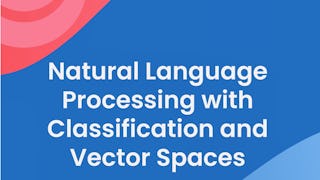This course offers a clear pathway to undertsand advanced tokenization and sentiment analysis—two core pillars of modern NLP. You'll learn how to convert raw text into structured input using subword, character-level, and adaptive tokenization techniques, and how to extract sentiment using rule-based, statistical, and deep learning models.


您将学到什么
Build smarter NLP pipelines with advanced tokenization methods like byte-pair encoding, subword units, and streaming-friendly strategies.
Create powerful text representations using character-level, hybrid, and sentence embeddings for real-world search, classification, and clustering.
Learn sentiment analysis with VADER, machine learning models, and transformer-based approaches like BERT and RoBERTa.
Analyze opinion trends, perform aspect-level and multilingual sentiment analysis, and ensure fairness and accuracy in sensitive applications.
您将获得的技能
- Text Mining
- Data Cleansing
- Applied Machine Learning
- Data Ethics
- Unified Modeling Language
- Large Language Modeling
- Artificial Intelligence and Machine Learning (AI/ML)
- Machine Learning Algorithms
- Deep Learning
- Data Processing
- Natural Language Processing
- Time Series Analysis and Forecasting
- Unstructured Data
- Machine Learning
- Data Analysis
- Responsible AI
要了解的详细信息
了解顶级公司的员工如何掌握热门技能

积累特定领域的专业知识
- 向行业专家学习新概念
- 获得对主题或工具的基础理解
- 通过实践项目培养工作相关技能
- 获得可共享的职业证书

该课程共有4个模块
In this module, learners will explore advanced techniques for breaking down and encoding text for machine understanding. They will examine subword, byte-level, and adaptive tokenization methods used in modern NLP models. The module also introduces character-level and hybrid embeddings, as well as sentence embeddings for capturing semantic meaning in tasks like search, classification, and clustering.
涵盖的内容
19个视频6篇阅读材料5个作业1个讨论话题2个插件
In this module, learners will explore the full range of approaches used to analyze sentiment in text, from rule-based lexicons to deep learning with transformer models. They will examine how sentiment is extracted, scored, and classified, and learn how to handle challenges like class imbalance, domain specificity, and low-resource settings. Practical demonstrations will help reinforce the application of models such as VADER, Naïve Bayes, BERT, and RoBERTa in real-world sentiment analysis tasks.
涵盖的内容
16个视频5篇阅读材料4个作业1个插件
In this module, learners will examine how sentiment analysis is applied in dynamic, multilingual, and high-impact environments. The lessons focus on tracking sentiment trends over time, extracting aspect-level opinions, and extending sentiment models across languages. Learners will also evaluate the ethical risks of sentiment modeling and explore how to design fair, accountable systems for sensitive applications like healthcare and justice.
涵盖的内容
19个视频6篇阅读材料5个作业
In this final module, learners will consolidate key concepts from the course through a structured summary, a real-world project, and a reflective assignment. The focus is on applying the full range of tokenization and sentiment analysis techniques in practical, domain-relevant scenarios. This module also encourages learners to evaluate their understanding and prepare for real-world NLP tasks by integrating technical knowledge with ethical and contextual awareness.
涵盖的内容
1个视频1篇阅读材料2个作业1个讨论话题1个非评分实验室1个插件
获得职业证书
将此证书添加到您的 LinkedIn 个人资料、简历或履历中。在社交媒体和绩效考核中分享。
从 Machine Learning 浏览更多内容
 状态:免费试用
状态:免费试用
Coursera Project Network
 状态:免费试用
状态:免费试用 状态:免费试用
状态:免费试用Edureka
人们为什么选择 Coursera 来帮助自己实现职业发展




常见问题
This course provides a deep dive into modern tokenization strategies and sentiment analysis techniques used in multilingual and domain-specific NLP tasks. It explores subword modeling methods like Byte-Pair Encoding (BPE), WordPiece, and SentencePiece, and examines character-level encoding approaches. Learners work with cross-lingual embeddings such as MUSE and LASER, and fine-tune models like mBERT and XLM-R for sentiment classification. The course also covers Aspect-Based Sentiment Analysis (ABSA), lexicon-based methods using VADER and SentiWordNet, and applies these techniques to real-world use cases like social media monitoring, political discourse analysis, and crisis event sentiment tracking.
Learners explore modern tokenization strategies, including Byte-Pair Encoding (BPE), WordPiece, SentencePiece, and character-level encoding, all crucial for subword-level text representation.
Yes. The course emphasizes multilingual and cross-lingual sentiment analysis, using shared subword vocabularies and models like mBERT and XLM-R to handle multiple languages effectively.
更多问题
提供助学金,
¹ 本课程的部分作业采用 AI 评分。对于这些作业,将根据 Coursera 隐私声明使用您的数据。


 中
中


